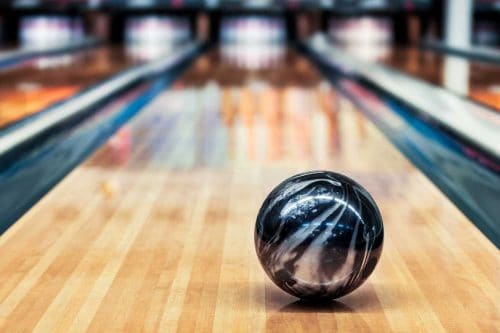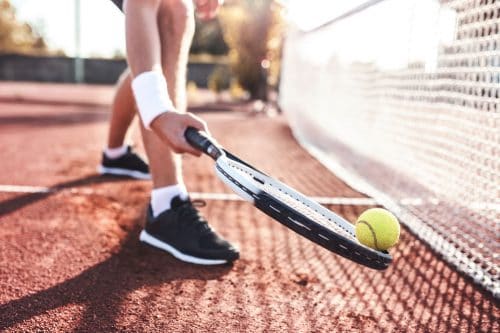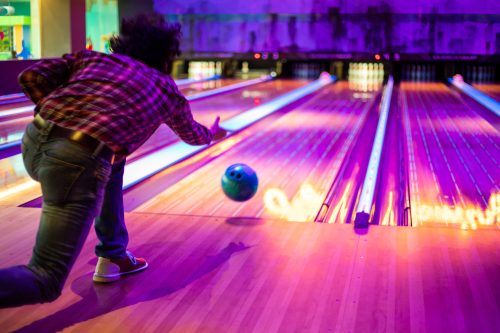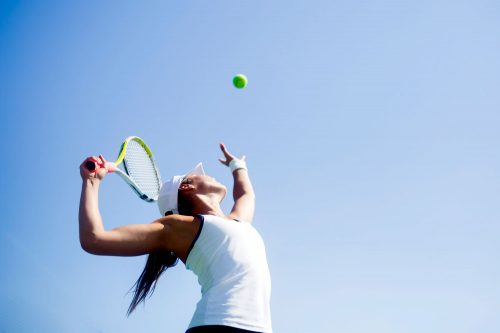Squash is an excellent way to get exercise while competing, which many people find easier than exercising alone. If you'd like to experience this fast-paced game, you'll need a few pieces of gear. We've researched what you need to play squash and have compiled this ultimate gear guide.
Here is the necessary gear to play squash:
- Racket
- Ball
- Goggles
- Non-marking shoes
- Athletic clothing
- Court
- Partner
![One squash racket and ball on wooden floor in four-walled court, What Do You Need To Play Squash? [The Ultimate Gear List]](https://fitseer.com/wp-content/uploads/2021/01/One-squash-racket-and-ball-on-wooden-floor-in-four-walled-court.-What-Do-You-Need-To-Play-Squash-The-Ultimate-Gear-List.png)
Racket
One of the most basic elements you need for a game of squash is a racket. This is what you'll use to strike the ball to serve or return it to your opponent. Squash rackets have a long handle with a small face. Usually, they're made out of composite materials such as fiberglass, carbon fiber, or titanium alloy. However, older rackets were made out of wood or ceramic.
The racket's face or head is made out of thin, strong fibers like nylon, polyamide, or other polymers. These strings are designed to be taut yet flexible so that the ball bounces off the racket. You might have to restring your racket every couple of years to keep the racket powerful.
How do you choose a squash racket?
There are several factors to look at when choosing a squash racket. If you want to make sure you're picking out the best one for your needs, go to a sporting goods store and test out their selection.
Balance
The racket's balance describes the heaviest part of the racket: head-heavy, head-light, or balanced. A head-heavy racket will be powerful since the head will gain more momentum. On the other hand, a head-light racket will give the player the most flexibility and speed since the racket is easier to control. If a racket is the same weight throughout, it's referred to as balanced.
A beginner squash player should opt for a balanced or head-light racket. This will help you learn the basics of the game without too much power.
Click here to view this racket on Amazon.
Weight
Similarly to balance, the weight of a racket affects its power and maneuverability. A light racket is normally somewhere from 110 to 130 grams. It lets you get plenty of speed behind each stroke and position the racket accurately. A heavy racket --between 130 and 145 grams-- is best for a player with a slow swing so that they can still get enough power behind their swing.
Click here to view this racket on Amazon.
Budget
Perhaps the biggest factor when choosing a racket is your personal budget. You can find a squash racket for as little as $20 or so, but if you want a quality racket, plan on spending somewhere between $60 and $125. Or, at the highest end, you could spend two or three hundred dollars. Here is an example of a quality, higher-priced racket with exceptional weight balance:
Click here to view this racket on Amazon.
Ball
A squash ball is made out of rubber and synthetic materials and is hollow in the middle. When it hits the racket or the wall, the ball deflates or squashes, which is the origin of the game's name. To get optimum use out of a squash ball, it has to be warmed up considerably. You can heat a squash ball by keeping it in a warm location, but the best way is to strike it repeatedly at a fast pace.
If a ball isn't warmed up enough, it won't bounce or come off the racket the right way. It will make the game difficult since you wouldn't be able to return a shot before it hits the ground. The difficulty level of a squash ball is represented by the color of a dot on the ball.
What do the colored dots on squash balls mean?
Squash balls are usually solid black with one or two colored dots. These dots are used to signify the ball's level of difficulty: how high it bounces, how hard it is to warm the ball up, and how heavy it is. A ball with two yellow dots is for experts and can only be properly warmed up by players who can strike the ball at extremely high speeds repeatedly.
Click here to view these balls on Amazon.
The measurement of how easy a squash ball is to use is hang time. A ball with a short hang time -- like one with two yellow dots -- is intended for more advanced players. This is because it doesn't hang in the air long enough to be returned.
Which squash ball is best for beginners?
A blue-dot ball is best for beginners. It is easiest to warm up, has the highest bounce, and has the longest hang time. If you're new to the game, you'll want to use a blue-dot ball like the ones below.
Click here to view these balls on Amazon.
Otherwise, here's a chart with the main levels of squash balls listed from beginner to advanced.
| Dot color | Bounce height | Speed (hang time) | Suggested player level |
| Double yellow | Low | Very short | Experienced player |
| Yellow | Low | Short | Good player |
| Green | Low/Medium | Medium | Good player |
| Red | Medium | Long | Beginners |
| Blue | High | Very long | Junior or debutants |
This is a set of green-dot squash balls, a mid-level ball for intermediate players.
Click here to view these balls on Amazon.
How long do squash balls last?
The lifespan of a squash ball depends on how long it's used, how hard it's struck, and the surface of the court. Players who strike the ball as hard as possible -- such as professional or collegiate players -- can only use a ball for a couple of hours. If you're just playing for fun, you can expect to use a ball for several matches.
A dead ball doesn't bounce as high or come off the racket as aggressively. Generally, you can tell when a squash ball is dead by its appearance. A dead ball will be shiny, having lost its texture. Or, some squash balls are designed for the logo to wear off when it's time to replace it. Of course, if your squash ball busts open, you should stop using it.
Can you use a racquetball for squash?
For best results, you shouldn't use a racquetball ball in your squash match. A racquetball ball is bigger than a squash ball: 2.25 inches in diameter versus 1.5 to 1.6 inches for a squash ball. It's also much bouncier than a squash ball, partly because a racquetball court is bigger than a squash court. This means that a racquetball ball will fly all over the smaller squash court, altering the game significantly.
What do you wear for squash?
Now that you've gotten the basic elements of a squash match, you'll need to make sure you're wearing the right clothes and safety gear.
Goggles
In general, squash is a safe game. There's no physical contact, and it's played indoors on a smooth surface. However, you're in danger of being struck by the ball. Getting hit by the ball on most parts of your body will sting for a while and might bruise, but if you're hit in the eye, it can cause irreparable damage.
Thus, it's important to wear safety goggles while playing. Look for any type of athletic safety gear, like rec specs or racquetball goggles.
Click here to view these goggles on Amazon.
There are also some goggles with a strap that goes around the back of your head to keep them from flying off.
Click here to view these goggles on Amazon.
If you prefer, goggles also feature detachable head-straps --so you can pick your ideal goggles and add a strap later.
Click here to view these goggles on Amazon.
Can you use tennis shoes for squash?
Your squash shoes should be non-marking and give you plenty of traction on the squash court. While this might be true of some tennis shoes, you'll want to check before wearing them on the court. Most tennis shoes are designed for outdoor courts and care more about breathability than indoor traction. In fact, many squash clubs won't let you play with black-soled shoes.
If you're going to be playing squash at a high level for long periods of time, you'll appreciate some extra cushion and shock absorption. These things are offered in a quality pair of squash shoes. These shoes are similar to handball or racquetball shoes. Here are a few examples.
Salming Men's Hawk Court
Click here to view these shoes on Amazon.
Salming Men's Kobra Mid 2
Click here to view these shoes on Amazon.
Salming Men's Hawk
Click here to view these shoes on Amazon.
Athletic clothing
Like most athletic endeavors, you'll want to wear breathable, sweat-wicking clothing. Essentially, wear what you'd wear for a trip to the gym to work out. This includes your socks, shorts, and shirt. We'll provide some good examples below.
However, the game of squash takes etiquette seriously. If you're playing at a squash club, recognize that it might have strict rules about apparel. General squash etiquette dictates that you shouldn't wear tank-tops, cutoff shirts, long pants, or torn clothing. Wear a t-shirt or collared shirt up top and shorts, a skirt, or a tennis dress below. The safest color to wear is white, as this is seen as most proper.
Men's Squash Wear
Click here to view these shirts on Amazon.
Click here to view these shorts on Amazon.
Click here to view these shorts on Amazon.
Women's Squash Wear
Click here to view this skirt on Amazon.
Click here to view this skirt on Amazon.
Sport Socks
Click here to view these socks on Amazon.
Click here to view these socks on Amazon.
Is squash hard to play?
Squash is a simple game to learn but is difficult to master. The rules are fairly simple, and the premise couldn't be clearer: beat your opponent by returning their shots before they bounce twice. It also only requires one partner, as opposed to other sports that need several players.
Because it's played on an enclosed court, it's easier than some other racket sports such as tennis or badminton. However, since the ball doesn't bounce as high as in racquetball, it might be considered more difficult. If you're looking for an easier but similar game, you might consider playing racquetball.
Non-Material Necessities
Now that you've got the right gear, there are a couple of other necessities to play a match: a court and a partner!
Can you play squash alone?
Like many things in life, squash is best enjoyed with a partner. While you can practice squash alone, you'll need a partner to compete against in a match. Otherwise, you'll simply be hitting the ball to yourself repeatedly.
If you simply want to improve your racket skills -- your aim, ball placement, ball speed, and power -- you can practice by yourself. This article has more details and some sample drills you can use to get better at the game by yourself: "Can You Play Squash Alone?"
Do you need a court to play squash?
A squash court is enclosed by four walls and has a smooth wooden floor. This allows players to strike the ball off all three walls, an important part of the game. It also gives players a true bounce off the ground so that the game is predictable. Furthermore, a squash court has specific lines to differentiate from in and out of bounds.
Trying to play this game without a correct court will result in frustration and an inaccurate game. Like a partner, though, you can improve your skills without a court. If you have a smooth wall and floor, you can get more accurate and powerful.
Curious about the elements of a squash court? Check out this article: "How Big Is A Squash Court (Inc. Dimensions Chart)."
Match Point
Squash is a fun-filled activity as long as you have the right gear. Make sure you have the right racket, ball, goggles, shoes, and athletic wear to be successful. All that's left is to find a partner and a court to get started. Good luck!




















![Read more about the article What Pants Do You Wear Snowboarding? [3 Options inc. examples]](https://fitseer.com/wp-content/uploads/2020/10/A-fully-geared-snowboarder-with-a-gradient-colored-goggles-trekking-on-the-snowy-trails-of-a-mountain-side-500x333.jpg)





The Tecnifibre glasses are a must. A ball in the eye is no fun. Speaking from experience…